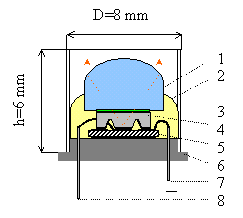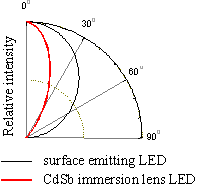| In
most practical applications of interest is the power received by detector rather than the
integral power of the LED. That’s why practical constructions contain beam concentrators
and lenses. The above described episide-down bonded LEDs well suite for the coupling with
the optical details since their emitting surface is flat and is free of any contacts.
That’s why it was not difficult to couple them with the
Si or CdSb immersion lens (D=3 mm, H=3
mm) by gluing them onto n+-InAs through the chalcogenide glass having
refractive index n=2.6 and melting temperature of about 60oC.
The output characteristics of the immersion lens LEDs
have shown nearly 3-5-fold increase of the emission power compared
to the uncoated LEDs for entire 3300-7000 nm range.
One of the advantages of the LEDs is the concentration of
the output beam shown in the right picture. The narrowing of the far field
beam pattern in the lens coupled LED is beneficial for the coupling with
detectors e.g. having the same lenses and construction. The output of the
developed LEDs is at least three times higher than that of the published
analogs that creates good perspective for their practical applications in
various gas analyzers.
|
|

1-Si or CdSb immersion
lens D=3.5 mm, 2- epoxy, 3-chalcogenide
“glue”, 4 –“flip chip bonded” LED or BSI photodiode,
5-Si submount, 6-TO-39
header, 7-cathode, 8-anode

|